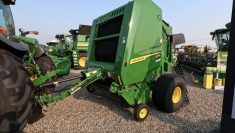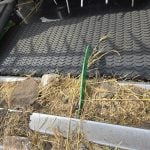Jeff Scott’s neighbours were concerned when he grew canola for the first time in 2004 in north-central Oklahoma.
“I had guys calling me and telling me that my turnips weren’t making (it),” said Scott, who farms near Pond Creek west of Tulsa.
“They had been out there digging up my turnips and there weren’t any turnips. I said that’s nice. It’s canola. Quit digging it up.”
Scott’s initial 10 acre experiment with winter canola has since grown to 1,500 acres.
Read Also

Saskatchewan agriculture sector receives federal funding
PrairiesCan funding will assist in the continued growth of Saskatchewan’s ag research and manufacturing sectors.
Some of his nosy neighbours are also growing the oilseed.
He estimated that 250 farmers now grow winter canola in Oklahoma, southern Kansas and Texas.
Southern plains farmers planted 135,000 acres of the winter oilseed last fall and Scott expects that figure to reach 250,000 acres this fall.
“We’ve doubled acreage nearly every year since we started,” said Scott, president of the Great Plains Canola Association, which represents 50 growers in the region.
He said many Oklahoma producers initially adopted canola as a way to kill problem weeds in their wheat fields.
Growers were frustrated with the brome grasses and feral rye that had invaded their farms after decades of monoculture agriculture.
“We are a continuous wheat state,” said Oklahoma canola agronomist Heath Sanders.
“I can take you to fields where they’ve grown wheat for 100 years.”
Scott decided to try winter canola after plant scientists at Oklahoma State University pitched him the concept.
“They asked us if we’d like to try growing canola…. I said sure, what is it?” he said.
“I’d never heard of the crop, but I’m just one those guys who is willing to try something new.”
Scott was intrigued because he saw winter canola as a herbicidal crop.
“It’s hard to kill a grass out of a grass,” he said. “But (with Roundup Ready canola), we’re able to use Roundup…. So we can use a grass killer in a broadleaf crop to clean up the fields. That’s why we originally started growing this crop.”
However, he quickly learned that it’s also possible to earn a profit from the crop. Winter canola has proven to be more profitable than winter wheat, which is why many producers now grow the oilseed.
“When you can make a $100 or $200 per acre … bonus growing canola than what you can (earn) growing wheat, why wouldn’t you want to?”
Yields may be lower this year because only 75 millimetres of rain has fallen on his farm since last July, but Scott said experienced canola growers in Oklahoma regularly produce crops that yield 36 bushels per acre or higher.
“We do see some 50 and 60 bushel yields.”
Bob Schrock, who farms near Kiowa, Kansas, near the Oklahoma border, was another of the region’s early adopters. However, his oilseed experiment was riskier.
“The first year I did 800 acres, which was kind of silly. Or gutsy or stupid,” said Schrock.
He initially struggled with false chinch bugs and diamondback moth larvae but wasn’t deterred. He now grows 1,600 to 2,500 acres of winter canola a year.
Schrock and other growers in southern Kansas were seeking a reliable alternative to winter wheat because temperatures in the region are too hot for corn, soybeans and sorghum.
“Winter canola versus our other options, it’s planted the same time (as wheat), it’s harvested the same time … and it takes advantage of our normal rainfall patterns.”
A rotation of canola, wheat and wheat offers agronomic benefits and increases wheat yields 25 to 50 percent when it follows canola, Scott said.
The taproot of the canola plant burrows deep into the soil profile, pulling up nitrogen that has leached out of the wheat’s root zone.
“We’re bringing (the nutrient) back to soil surface and replenishing the topsoil with the nitrogen from the decaying canola plant matter,” he said.
“I can save myself 35 bucks an acre on fertilizer (for wheat) alone by having a canola rotation.”
Researchers and plant scientists are paying more attention to canola as acres expand in Kansas, Oklahoma and Texas. Plant breeders at Kansas State and Oklahoma State universities have developed varieties with higher yields, more oil content and greater cold tolerance.
“We’ve got extreme winter tolerance now in these winter varieties,” said Sanders, an oilseed agronomist with Producers Co-operative Oil Mills of Oklahoma City.
“We actually got down to negative 20 below (Fahrenheit) this winter and we’ve got good looking canola right now.”
He said the co-operative began crushing canola three years ago.
“We don’t have enough cotton seed to crush year round, so we were looking for another crop and canola fit very well.”
The co-operative expects canola acres to expand rapidly in the southern plains and is building another plant to crush canola and other oilseeds.
“The new plant will do right around 800,000 to a million (canola) acres,” Sanders said.
“I’m thinking there will be more than that (because) the market is here and it’s profitable for farmers to grow it.”
Scott is optimistic about canola’s future in the region. He said growers could soon produce more canola than farmers in North Dakota.
“If you look at the Great Plains region … we’re looking at 25 million acres, or more, planted to winter wheat every year. If we could get a 10 percent canola adoption, that’s 2.5 million acres.”
Schrock said it’s hard to know if winter canola will ever top one million acres in the southern plains, but for now he still gets a kick out of growing the oilseed with the bright, yellow flowers.
“To see a little tiny thing, as a seed, turn into a big bush and have birds nest in it … It’s just a cool and an amazing plant.”















